History of Marchbanks Speedway, aka Hanford Motor Speedway
 Thursday, April 8, 2010 at 9:42 PM
Thursday, April 8, 2010 at 9:42 PM RELATED STORIES: Read more about Marchbanks Speedway and Hanford Motor Speedway in my Marchbanks section.
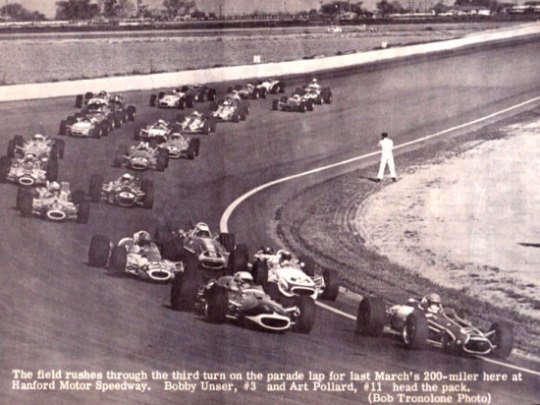 Start of the March 1968 Champ Car race at Hanford Motor SpeedwayThis is an evolving history of Marchbanks Speedway, a racetrack just south of Hanford, Calif., that went by several names and layouts over its two-decade life.
Start of the March 1968 Champ Car race at Hanford Motor SpeedwayThis is an evolving history of Marchbanks Speedway, a racetrack just south of Hanford, Calif., that went by several names and layouts over its two-decade life.
Marchbanks, aka Hanford Motor Speedway, remains little known today but was the first superspeedway west of the Mississippi, and hosted big-name NASCAR and Indy Car races in the 1950s-60s. These days, the track ceases to exist physically and its history lives online only in scattered references on racing forums and enthusiast sites.
My goal with this post is to try to build a history of Marchbanks and give it the legacy it deserves. In light of recent efforts to build a $400 million track in nearby Tulare County, I think it's important for people to know the area already has a rich history in hosting some of the greatest racers of all time. It's amazing to me that a track that brought national attention to the small town of Hanford, in the heart of Central California, has been left out of local history books and mentioned sparingly in racing publications.
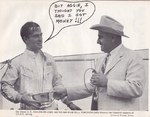 Bill Vukovich II drove four races at Hanford for car owner J.C. "Aggy" Agajanian, who doubled as Hanford's promoter. This shot was in the 1967 Hanford Champ Car race program.Billl Vukovich II told me, "Why would anyone want to write a history about Hanford (Motor Speedway)?" Vukovich was not a fan of the track despite two Top 10 finishes in Champ Car races there in the late 1960s, and had nothing good to say about the speedway. "That place was in the middle of nowhere." Indeed it was, but for any number of reasons, a lot of people have good memories of the place.
Bill Vukovich II drove four races at Hanford for car owner J.C. "Aggy" Agajanian, who doubled as Hanford's promoter. This shot was in the 1967 Hanford Champ Car race program.Billl Vukovich II told me, "Why would anyone want to write a history about Hanford (Motor Speedway)?" Vukovich was not a fan of the track despite two Top 10 finishes in Champ Car races there in the late 1960s, and had nothing good to say about the speedway. "That place was in the middle of nowhere." Indeed it was, but for any number of reasons, a lot of people have good memories of the place.
My quest to look into the Marchbanks story began with a 2009 blog post and I’ve since dug deeper by visiting Hanford, interviewing people who were closely involved with the track, purchasing photos and videos, and poring over more than 50 web sites (complete list of sources and links are at the bottom of this post). Of particular value were personal recollections from hardcore fans on Track Forum who spent time at the track during its heyday. There's much more to uncover, and I’ll add other information, including more personal interviews, as I can. But this is a start.
I’d love for this track history to be collaborative. Please share any knowledge, tips, corrections or other information, either by commenting below or by contacting me directly. And while I constantly update this general history of the track, I regularly post interviews and more detailed updates in my Marchbanks section.
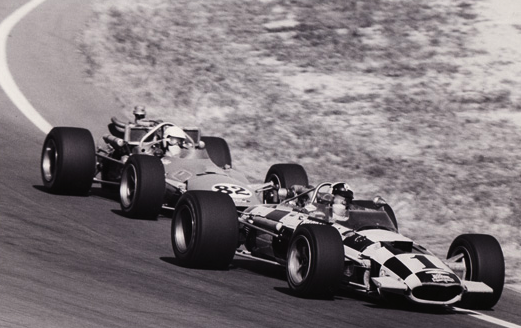 Bobby Unser leads Roger McCluskey during 1969 Champ Car race at Hanford Motor Speedway. The race was the last national event held at the track.
Bobby Unser leads Roger McCluskey during 1969 Champ Car race at Hanford Motor Speedway. The race was the last national event held at the track.
History of Marchbanks Speedway, aka Hanford Motor Speedway
Marchbanks Speedway was a lot of things in its two-decade life: dirt and asphalt half-mile oval, 1.4-mile paved tri-oval with two smaller infield ovals, road course, even a spot where dragboats found room to race on its infield.
The track, also known as Marchbanks Stadium and Hanford Motor Speedway, featured some of the biggest names in racing: Fireball Roberts, A.J. Foyt, Parnelli Jones, Gordon Johncock, Johnny Rutherford, Mario Andretti, Mel Kenyon, George Follmer and the Unsers to name just a few. Its races were televised nationally, bragging rights for a small Central California town in the middle of nowhere. It was, as described in "The Stock Car Racing Encyclopedia," "California's first high-banked paved superspeedway to be run under NASCAR sanction."  The Okada-Trader Special was a hot car in the hands of Tommy Trader at Marchbanks Stadium in 1953. From left to right: Pete Morrison, Frank Okada, Forrest Nelson, Chuck Souza, Tom Trader and Bob Trader. (Photo courtesy of Tommy Trader).Sadly, there's no official history of the track once described as a "baby Daytona."
The Okada-Trader Special was a hot car in the hands of Tommy Trader at Marchbanks Stadium in 1953. From left to right: Pete Morrison, Frank Okada, Forrest Nelson, Chuck Souza, Tom Trader and Bob Trader. (Photo courtesy of Tommy Trader).Sadly, there's no official history of the track once described as a "baby Daytona."
“It's a shame the place never really made it big," a person with the handle "Hubbster" posted on Track Forum. "That's a real racing area, the Central Valley. Stocks, sprinters, midgets, supers, karts, sports cars ... just about anything you can think of has a following. The fan base is certainly there.
"Hanford falls into that category of "What Might've Been" along with Ontario and Trenton. Who knows? It remains one of the most mysterious race tracks of all time. Little known. Little remembered.”
The beginning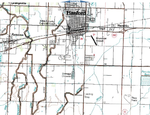 This 1993 U.S. Geological Survey map shows the tri-oval about 8 miles southeast of HanfordFarmer B.L. "Bircha" Marchbanks built the track in the middle of cotton and corn fields southeast of Hanford after failing to get approval for his first plans: a horse-racing track that would support legalized betting. Marchbanks staged his first rodeo at what became Marchbanks Stadium in 1950 on a half-mile track that featured a quarter-mile straightaway for quarter-horse racing. When the prospects for legalized betting faded, Marchbanks focused on auto racing and debuted with jalopy races on or around May 10, 1951.
This 1993 U.S. Geological Survey map shows the tri-oval about 8 miles southeast of HanfordFarmer B.L. "Bircha" Marchbanks built the track in the middle of cotton and corn fields southeast of Hanford after failing to get approval for his first plans: a horse-racing track that would support legalized betting. Marchbanks staged his first rodeo at what became Marchbanks Stadium in 1950 on a half-mile track that featured a quarter-mile straightaway for quarter-horse racing. When the prospects for legalized betting faded, Marchbanks focused on auto racing and debuted with jalopy races on or around May 10, 1951.
And while there is some disagreement on racing forums about the track’s location, the track was just northeast of Highway 43 (8th Avenue) and Idaho Avenue, about 5 miles southeast of Hanford (roughly Longitude -119.59599 and Latitude 36.26624). I could post a photo of what the place looks like now but all you need to do is imagine flat farmland.
It’s interesting to see changes on U.S. Geological Survey maps 40 years apart that show two different track layouts. The July 1, 1954, map shows a small oval with long straights and sharp turns, while USGS maps from July 1971 and 1993 (long after the track was razed) show a larger tri-oval with the smaller and tighter oval within. That matches with the two incarnations of the track: A dirt half-mile oval in the 1950s and a paved tri-oval in the 1960s and beyond.
The owners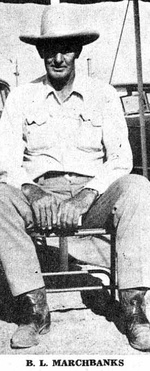 Even in the early days of NASCAR, Bill France Sr., founder of National Association of Stock Car Automobile Racing, saw opportunity to broaden the series of his Southern-based series in California. He found a willing partner in B.L. Marchbanks, who built a half-mile dirt oval and hosted NASCAR’s premier Grand National Series in 1951. That year, NASCAR held five Grand National races in California, including the 200-lapper at the new Marchbanks Speedway.
Even in the early days of NASCAR, Bill France Sr., founder of National Association of Stock Car Automobile Racing, saw opportunity to broaden the series of his Southern-based series in California. He found a willing partner in B.L. Marchbanks, who built a half-mile dirt oval and hosted NASCAR’s premier Grand National Series in 1951. That year, NASCAR held five Grand National races in California, including the 200-lapper at the new Marchbanks Speedway.
NASCAR driver Rex White, writing in his autobiography “Gold Thunder: Autobiography of a NASCAR champion” recalled meeting B.L. at Daytona in 1960.
“While in Daytona, I met a character from California named Marchbanks. Everywhere he went, he wore a cowboy hat and boots. He’d come from California to get drivers to run his new track in Hanford.”
Marchbanks paid White and Joe Weatherly to make the trip west to Marchbanks, but according to William Burt's book "The American Stock Car," "the prize money for the event was not lucrative enough to get the Southern drivers to drag a car all the way to California, so the top drivers had informally decided not to race. They all agreed, except for Rex White. He went to California, finished eighth and collected close to 500 points. This helped Rex win the 1960 championship."
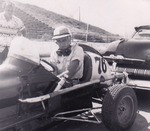 I don't have any detail about this photo other than it was shot in 1953 in front of the Marchbanks Stadium grandstands. (Photo courtesy of Tommy Trader). Trudy Frye of Bakersfield wrote me with recollections of Marchbanks as a young girl growing up in Hanford. "Mr. Marchbanks and Daddy were friends. ... They were both dreamers, and became friends." In a follow-up e-mail, Frye recalled Marchbanks as "a big man in a cowboy hat with a sweet smile. He bent over to shake my hand, like I was an adult, when we met, and always tipped his hat to me after that."
I don't have any detail about this photo other than it was shot in 1953 in front of the Marchbanks Stadium grandstands. (Photo courtesy of Tommy Trader). Trudy Frye of Bakersfield wrote me with recollections of Marchbanks as a young girl growing up in Hanford. "Mr. Marchbanks and Daddy were friends. ... They were both dreamers, and became friends." In a follow-up e-mail, Frye recalled Marchbanks as "a big man in a cowboy hat with a sweet smile. He bent over to shake my hand, like I was an adult, when we met, and always tipped his hat to me after that."
Marchbanks also promoted races at the Kearney Bowl in Fresno, Bakersfield Speedway and in Atascadero.
I found a published reference to Marchbanks Sports Club Inc. as early as 1958.
A Bakersfield Californian story in April 1963 said Marchbanks leased the track to Bakersfield race promoter Ed York for the 1963 season.
That didn't last and B.L.'s son Bonnie and grandson Gary took ownership of the track in 1964 and leased it to K&S Racing Enterprises, owned by Southern California businessman Kalmon Simon (also referred to, correctly, as Kal and, incorrectly, as Cal) from 1964-69. A 1964 Oakland Tribune story said K&S had signed a 20-year lease, adding "T.L. Francis, vice president and general manager of K&S Enterprises, said the stadium will be renamed the Hanford Speedway and will be renovated for big time auto racing."
Famed promoter J.C. Agajanian worked with Simon to bring high-profile USAC Champ Car races to the track in 1967-69. When USAC balked at scheduling more races at Hanford without $750,000 in improvements, Agajanian launched a failed effort in 1970 to issue public stock at $25 per share to take over the speedway and host Champ Car and stock car races.
Name changes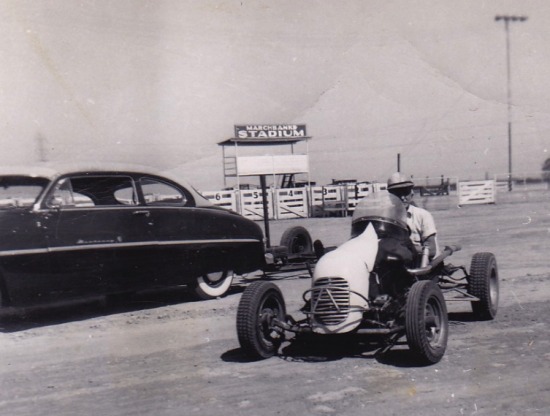 The person in this 1953 photo from Marchbanks Stadium is unidentified. This shot appears to be from the grandstand looking toward the infield rodeo grounds. (Photo courtesy of Tommy Trader, who won many races at Marchbanks that year)The track's name evolved over the years. What started as Marchbanks Stadium was later referred to, either formally or informally, as Marchbanks Speedway, Hanford Raceway (which also has been used to describe Kings Speedway, a dirt oval at the nearby Kings County Fairgrounds), Hanford Speedway and Hanford Motor Speedway, name changes that seemed to be triggered by renovations or changes in management. Although I found published references to Hanford Motor Speedway as early as 1960 and Marchbanks Stadium as late as 1963, the general timeframe has the track named Marchbanks Stadium up to 1960, Marchbanks Speedway from 1960-64, Hanford Speedway in 1964-65 and Hanford Motor Speedway thereafter.
The person in this 1953 photo from Marchbanks Stadium is unidentified. This shot appears to be from the grandstand looking toward the infield rodeo grounds. (Photo courtesy of Tommy Trader, who won many races at Marchbanks that year)The track's name evolved over the years. What started as Marchbanks Stadium was later referred to, either formally or informally, as Marchbanks Speedway, Hanford Raceway (which also has been used to describe Kings Speedway, a dirt oval at the nearby Kings County Fairgrounds), Hanford Speedway and Hanford Motor Speedway, name changes that seemed to be triggered by renovations or changes in management. Although I found published references to Hanford Motor Speedway as early as 1960 and Marchbanks Stadium as late as 1963, the general timeframe has the track named Marchbanks Stadium up to 1960, Marchbanks Speedway from 1960-64, Hanford Speedway in 1964-65 and Hanford Motor Speedway thereafter.
The various sizes and shapes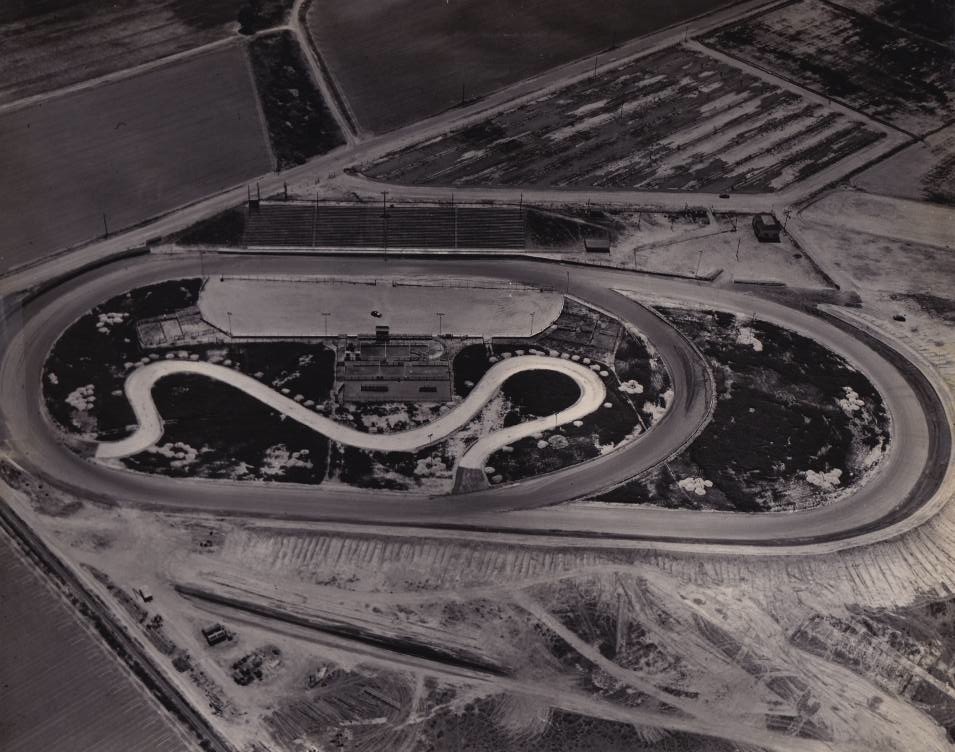 An aerial of the track in 1953 shows a one-third mile oval within a half-mile oval and a short infield section that created a five-eighth mile road course. The area between the grandstands and the infield was a rodeo ground (Photo courtesy of Tommy Trader). Information on the track specs varies wildly from source to source, with loose time frames, layouts and distances. There are numerous references to dirt and paved infield ovals, two different road courses and a dragboat lake, and a fearsome Turn 1 throughout all incarnations.
An aerial of the track in 1953 shows a one-third mile oval within a half-mile oval and a short infield section that created a five-eighth mile road course. The area between the grandstands and the infield was a rodeo ground (Photo courtesy of Tommy Trader). Information on the track specs varies wildly from source to source, with loose time frames, layouts and distances. There are numerous references to dirt and paved infield ovals, two different road courses and a dragboat lake, and a fearsome Turn 1 throughout all incarnations.
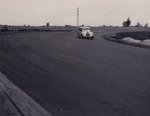 Tommy Trader's No. 13 on the asphalt at Marchbanks Stadium in 1953 (Photo courtesy of Tommy Trader). What doesn't seem to be in doubt is that Marchbanks started as a half-mile dirt oval, and stayed that way for a few years. The photo to the right shows asphalt in 1953, and a news story from that year refers to the "new asphalt track."
Tommy Trader's No. 13 on the asphalt at Marchbanks Stadium in 1953 (Photo courtesy of Tommy Trader). What doesn't seem to be in doubt is that Marchbanks started as a half-mile dirt oval, and stayed that way for a few years. The photo to the right shows asphalt in 1953, and a news story from that year refers to the "new asphalt track."
Studebakerracing.com reports that a NASCAR Short Track Series race at Marchbanks in June 1955 was on a 5/8-mile oval that had paved straights and dirt turns, but I have not confirmed that and Gary Marchbanks did not recall that kind of mixed surface. The 100-lap NASCAR race covered 62 miles, indicating the track may have grown from a half-mile to 5/8ths since that first  Tommy Trader, No. 13, tries to get through a pileup at Marchbanks Stadium in 1953. Note the loose wheel in the upper left. (Photo courtesy of Tommy Trader).NASCAR race in 1951. I haven't found a second source for this information either.
Tommy Trader, No. 13, tries to get through a pileup at Marchbanks Stadium in 1953. Note the loose wheel in the upper left. (Photo courtesy of Tommy Trader).NASCAR race in 1951. I haven't found a second source for this information either.
George Benson, who raced at Marchbanks/Hanford during its three major incarnations, said that when he drove his first midget race in 1955, "the track at that time was a 3/8-mile oiled dirt pavement surface that got very slick when it got sandy from the native soils that surrounded the track. When it got oily it was even worse. It was relatively flat in both turns."
Benson also recalls winning a 1959 hardtop race on the half-mile oval that now shared a turn with the tri-oval under construction.
"The first turn was a high-bank turn for the 1-1/2-mile track, still under construction, that blended into the backstretch and flat second turn of the old half-mile flat tack," Benson wrote in his book "The Racing Years."
Exactly when Marchbanks became a fully paved tri-oval incorporating the infield ovals and road course 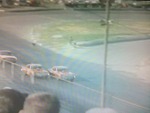 Parts of two smaller ovals are visible from within the larger tri-oval during the USAC Stock Car race in November 1964. Both of the small ovals shared Turn 1 with the larger tri-ovalremains unclear, although published reports document road racing at the track beginning in 1960.
Parts of two smaller ovals are visible from within the larger tri-oval during the USAC Stock Car race in November 1964. Both of the small ovals shared Turn 1 with the larger tri-ovalremains unclear, although published reports document road racing at the track beginning in 1960.
Frye recalls driving "around the nearly completed triangle track in our 1955 Buick Roadmaster" with her parents in about 1958. Onedirt.com and "The Stock Car Racing Encyclopedia" reported that Marchbanks re-opened as a 1.4-mile paved track in June 1960, which is close to the 1-3/8-mile distance the Marchbanks listed on a brochure for the 1961 NASCAR race.
MotoRacing in September 1960 described a 1.8-mile, 10-turn road course and "Monza-type banking where a minimum speed of 85 mph is required to keep the racing machine up on the banked wall." The cost of the 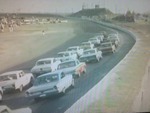 The berm grandstands are off in the distance as USAC stock cars prepare to start a 1964 race at Hanford Speedway. The pits are off to the left.new course was listed at $700,000.
The berm grandstands are off in the distance as USAC stock cars prepare to start a 1964 race at Hanford Speedway. The pits are off to the left.new course was listed at $700,000.
A Bakersfield Californian article a few days before the June 1960 NASCAR Grand National race said: "The banked track has one turn labeled dangerous by the drivers. That is the southwest turn, which is in front of the grandstand. One car went through the wall during the practice runs."
The tri-oval was lengthened slightly at some point in the early 1960s with the addition of a kink that took it closer to a real 1.4 miles, as shown in these two layouts from TheRacingLine.net. Racing Line pegs the first layout at 1.33 miles and the second, with the addition of slight kink along the homestretch, at 1.4 miles. At least one reader on Track Forum questions the drawings, saying the layouts don't match with reality
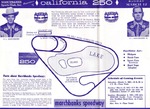 Brochure promoting the 1961 NASCAR Grand National race has a nice map of the various tracks (Brochure courtesy of Gary Marchbanks).
Brochure promoting the 1961 NASCAR Grand National race has a nice map of the various tracks (Brochure courtesy of Gary Marchbanks).
And there appeared to some "rounding up" on that track distance. The Dick Wallen video of the 1964 USAC stock car race has the announcer describing the track as a “mile-and-a-half high bank with a 30-degree bank in Turn 1,” and official USAC scoring sheets from 1967-69 list the track as 1.5 miles. (SIDE NOTE: To further the mystery, the announcer in the Dick Wallen video also referred to A.J. Foyt “tapping the wall in Turn Four." In those days races were rarely televised live, if at all, so I suspect the announcer was uninformed and may not have actually been at the track).
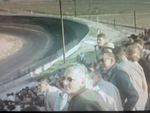 The intimidating high-bank Turn 1, as seen during the 1964 USAC stock car raceGerald Laurie, a regular at the track, posted on Track Forum that he saw sprint cars run the 5/8-mile oval, early modified couples on the 1.3-mile tri-oval, USAC stock cars on both the 1.3-mile and 1.4-mile tracks and Indy Cars on the 1.4-mile track. Laurie shared on Track Forum great detail on the track and its nuances:
The intimidating high-bank Turn 1, as seen during the 1964 USAC stock car raceGerald Laurie, a regular at the track, posted on Track Forum that he saw sprint cars run the 5/8-mile oval, early modified couples on the 1.3-mile tri-oval, USAC stock cars on both the 1.3-mile and 1.4-mile tracks and Indy Cars on the 1.4-mile track. Laurie shared on Track Forum great detail on the track and its nuances:
“The original track had a 1.3 mile triangle, a 5/8 egg shaped oval, and a 1/4 mile egg shaped oval, They all shared turn one which was banked over 30 degrees at the top (the banking increased in steepness as you got higher in the corner). In fact it was banked so high near the wall that top thirty or so feet of paving was actually oiled dirt because they couldn't get a paving machine up there. The front straight had about a five degree turn to the left where it came back to join the two short ovals. Turn one of the triangle was about 155 degrees of arc, turn two was banked about 8 degrees and was just under 90 degrees of arc, and turn three was was about 12 degrees banking and about 110 degrees of arc (remember there was another 5 degree kink in the front staight to complete the course. ..."
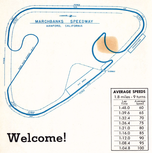 This 1960 diagram shows details of the Marchbanks road course. To settle bets, the best source might be a detailed map inside an official program from September 1960 road races at the track that shows these dimensions:
This 1960 diagram shows details of the Marchbanks road course. To settle bets, the best source might be a detailed map inside an official program from September 1960 road races at the track that shows these dimensions:
- A 222-foot radius southern turn (Turn 1 on the oval track) banked at 22 degrees
- A 476-foot radius northeastern Turn 2 banked at 22 degrees
- A northwestern turn (Turn 3 on the oval) at 18 degrees in the tight 282-foot radius on the eastern side and 17 degrees on the western 470-foot radius.
The 1964 Dick Wallen video shows what appears to be a slight rise in elevation at that kink on the homestretch in front of the stands. Permanent seating appeared to be confined to one big berm on the homestretch toward Turn 1. The track surface was inconsistent, and oil seemed to be heavier in spots, perhaps a contributor to the many spins in that race. The infield was a mess, with deep tire ruts in once-muddy areas interspersed with tumbleweeds and other wild growth. There was very little apron, and on several occasions, racers spinning off track hit the ruts, stressing suspensions like nobody's business. These ungroomed parts of the infield probably were part of the dry infield lake.
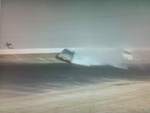 A man jumps back from the retaining wall as John Ward and Bill Myers spin in Turn 3 in the 1964 USAC Stock Car race at Hanford. You can see variations in the track surfaces, particularly toward the wall "Linker48x," posting on Track Forum, recalled:
A man jumps back from the retaining wall as John Ward and Bill Myers spin in Turn 3 in the 1964 USAC Stock Car race at Hanford. You can see variations in the track surfaces, particularly toward the wall "Linker48x," posting on Track Forum, recalled:
"I went to stock car, Indy car, and sports car and motorcycle road races at Marchbanks. ... As a tri-oval, the problem was turn 1, because while the banking was huge and high, the actual line was down on the apron and slow, so for instance, with Indy cars they dropped a lot of speed and then labored to get back up to speed on the backstretch. But they sure hauled a** down the front getting to turn 1! ... Also remember that there wasn't really macadam pavement, more like tar, that got soft and sticky on a hot day."
"aXe," also writing on Track Forum, recalls the sound of 10,000 fans on "steel temporary grandstands." When "everyone jumped up at once the stands felt like they were coming down."
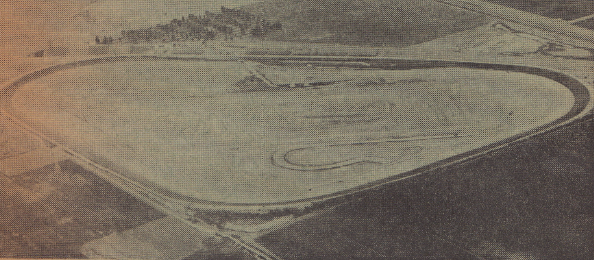 An aerial photo published in the San Francisco Chronicle in the days before the March 1967 Indy Car race shows the track after a $2 million renovation. The grandstand is in the upper left, and an infield road course is clearly visibleThe track underwent a $2 million renovation in advance of a 1967 Champ Car race. According to an Oct. 18 story in the San Francisco Chronicle, the refurbished track was a massive 90 feet wide, with 11- to 12-degrees of banking. The Chronicle reported seats for 20,000, some of them temporary, were in place for the debut Champ Car race.
An aerial photo published in the San Francisco Chronicle in the days before the March 1967 Indy Car race shows the track after a $2 million renovation. The grandstand is in the upper left, and an infield road course is clearly visibleThe track underwent a $2 million renovation in advance of a 1967 Champ Car race. According to an Oct. 18 story in the San Francisco Chronicle, the refurbished track was a massive 90 feet wide, with 11- to 12-degrees of banking. The Chronicle reported seats for 20,000, some of them temporary, were in place for the debut Champ Car race.
"The drivers rate the Hanford track second to Indy's," reported Everett Feay of The Fresno Bee. "But, they feel, the fans get a better deal in Hanford as the cars tend to stay bunched while the cars string out at Indy."
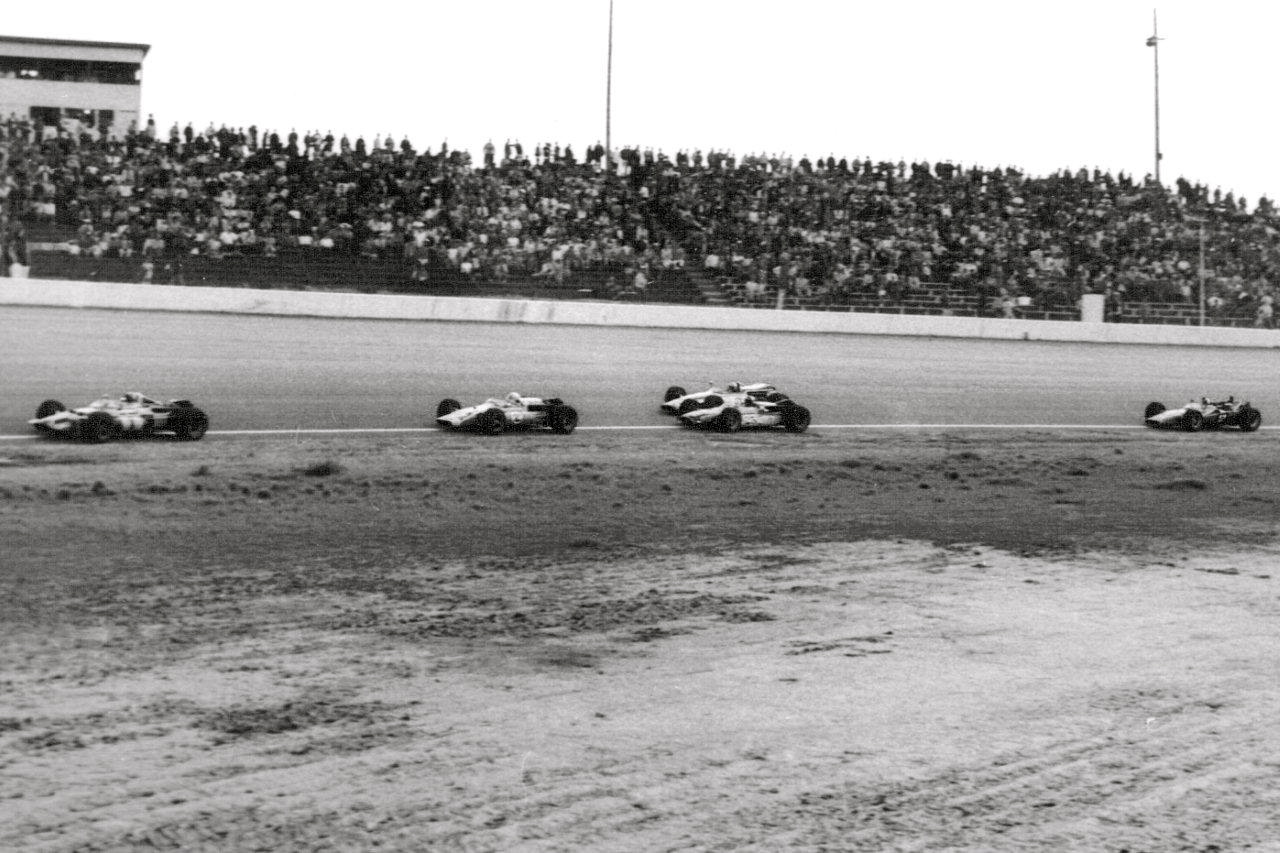 Bobby Unser leads during the 1969 Champ Car race at Hanford Motor Speedway. The grandstands were along the front straight and into Turn 1. Temporary bleachers were placed at other areas of the track. (Photo Copyright ©2011 Ken Durham, www.GearHeadPhotography.com)
Bobby Unser leads during the 1969 Champ Car race at Hanford Motor Speedway. The grandstands were along the front straight and into Turn 1. Temporary bleachers were placed at other areas of the track. (Photo Copyright ©2011 Ken Durham, www.GearHeadPhotography.com)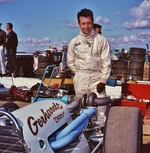 Mel Kenyon before the March 1968 Champ Car race. (Photo courtesy of John Isom). Legendary open-wheel driver Mel Kenyon raced at Hanford for the three Champ Car races in 1967 and 1968, driving for Fred Gerhardt.
Mel Kenyon before the March 1968 Champ Car race. (Photo courtesy of John Isom). Legendary open-wheel driver Mel Kenyon raced at Hanford for the three Champ Car races in 1967 and 1968, driving for Fred Gerhardt.
"I thought Hanford was a pretty nice racetrack," Kenyon told me in a telephone interview from his home in Lebanon, Ind. "It was smooth and you could see all the way around it. No trees -- not like Indy, where you can only see a straightaway at a time -- you could see all the way across it."
Kenyon recalls the tri-oval being a challenge to drive, like the similarly shaped Pocono.
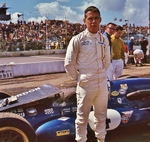 Gordon Johncock before the March 1968 race and a rare look at the grandstands. (Photo courtesy of John Isom)."Set-up was a challenge because of the three corners and the different degrees of banking, Kenyon said. "One was always good, one was medium and one was 'hang on!' "
Gordon Johncock before the March 1968 race and a rare look at the grandstands. (Photo courtesy of John Isom)."Set-up was a challenge because of the three corners and the different degrees of banking, Kenyon said. "One was always good, one was medium and one was 'hang on!' "
Former Fresno resident Harold "Bucky" Bolton told me in an email that he attended one race, the deadly 1969 Champ Car race won by Mario Andretti. "A friend of mine who had two pit passes for Lloyd Ruby's car gave me one. The thing I remember most was its huge high banks; it looked to me like a giant Bristol raceway with lake in the middle of it. It was an impressive track. It seems like the cars were running full out on its mile or so course. Mario was doing 158.357 miles per hour in practice."
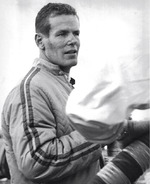 Bobby Unser did well in his four Champ Car races at Hanford but he wasn't a fan of the track surface. This is Unser after finishing second to A.J. Foyt at Hanford in November 1968. (Photo Copyright ©2011 Ken Durham, www.GearHeadPhotography.com)Andretti told me in an interview that Hanford was a test of skills.
Bobby Unser did well in his four Champ Car races at Hanford but he wasn't a fan of the track surface. This is Unser after finishing second to A.J. Foyt at Hanford in November 1968. (Photo Copyright ©2011 Ken Durham, www.GearHeadPhotography.com)Andretti told me in an interview that Hanford was a test of skills.
I liked the layout," Andretti said. "I liked that it had different radius corners. It required a compromise in the setup. I liked that extra challenge."
Bobby Unser, on the other hand, wasn't a fan of the track's surface, even though he finished second, fifth, second and seventh in his four races at Hanford.
"We had good races there but I distinctly remember sand when we raced there," Unser told me in a telephone interview. "It was a "big slide for life" type of deal, that's what Hanford was."
The road courses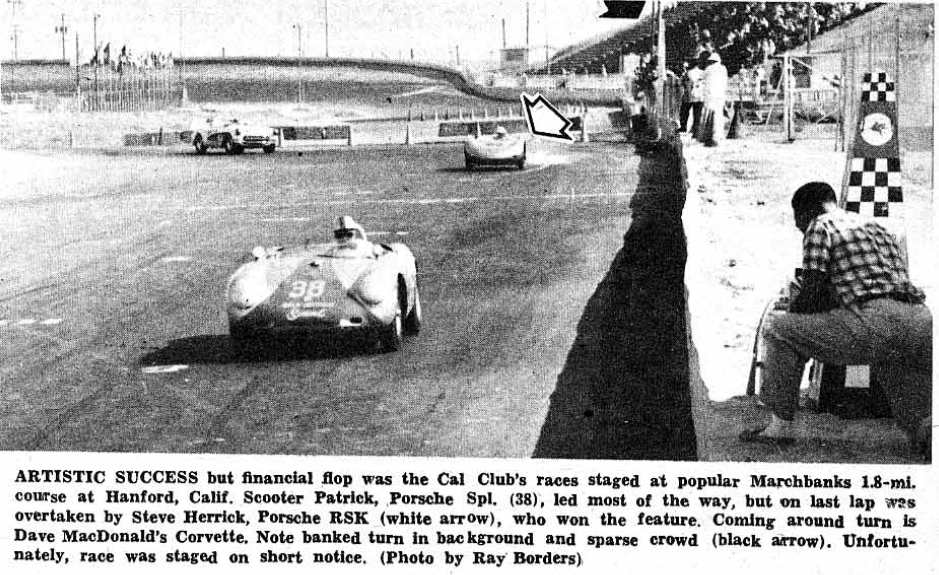 MotoRacing published this telling photo of Cal Club sports car races in September 1960, with cars running clockwise.Not a whole lot is written about the infield road course, but there were at least two incarnations. The 1953 aerial photo of Marchbanks Stadium shows the half-mile oval modified to include a windy stretch in the infield between turns 2 and 3 that made a "road" course of five-eighths mile.
MotoRacing published this telling photo of Cal Club sports car races in September 1960, with cars running clockwise.Not a whole lot is written about the infield road course, but there were at least two incarnations. The 1953 aerial photo of Marchbanks Stadium shows the half-mile oval modified to include a windy stretch in the infield between turns 2 and 3 that made a "road" course of five-eighths mile.
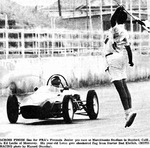 Racing with panache during a Cal Club meet in July 1961 (photo from MotoRacing)The rebuilding of the track into a tri-oval in the late 1950s included a much larger road course. "The History of the American Speedway" says a 2.5-mile paved road course existed from the "late 1950s" to approximately 1962, but that book erred on other elements of the track history so I use that reference with caution.
Racing with panache during a Cal Club meet in July 1961 (photo from MotoRacing)The rebuilding of the track into a tri-oval in the late 1950s included a much larger road course. "The History of the American Speedway" says a 2.5-mile paved road course existed from the "late 1950s" to approximately 1962, but that book erred on other elements of the track history so I use that reference with caution.
Reader Bob Dayton shared a story about driving the road course in 1959.
MotoRacing reported races at a 1.8-mile, 10-turn layout beginning in September 1960s, and at that time said Marchbanks began work on the road-course layout "seven years ago," indicating work on the road course began in 1953-54. MotoRacing said in 1960 the road course construction cost $700,000.
"The Stock Car Racing Encyclopedia" says the road course "was closed circa 1965." The photo immediately above is from a road course race in 1960 and the aerial above shows a road course existed after renovations in 1967, and they look to share the same general layout. But I have been unable to find any reference to road races after the track was renovated in 1967.
A MotoRacing report on a Sept. 18, 1960, California Sports Car Club race at Marchbanks described a "new Daytona-type circuit, with its 18- and 22-degree banking and tight infield turns, should turn into one of California's most popular courses. Minor paving problems -- the track broke up in several places -- was the major, and practically the only criticism of this lay-out."
MotoRacing described three banked turns, including a "17-degree," 470-foot radius turn that dropped into the infield then reappearing "on the 22-degree banking across from the start-finish." Winning average speeds ranged from 59 to 65 mph, depending on the class, which included formula cars and motorcycles.
 Racing tag from a Formula Racing Association event in October 1961."Linker48x," posting on Track Forum, recalled: "This was a BIG track for road racers, they came off the banked back corner for a sort of fast chicane, then to the last banked corner, then came down the front straight and turned left into the halfmile (5/8?) corner, went around to the quarter mile corner and turned right and rejoined the front straight. I think I also recollect them running it backwards (clockwise) at a Cal Club race with AFM bikes in about, say, 62-63."
Racing tag from a Formula Racing Association event in October 1961."Linker48x," posting on Track Forum, recalled: "This was a BIG track for road racers, they came off the banked back corner for a sort of fast chicane, then to the last banked corner, then came down the front straight and turned left into the halfmile (5/8?) corner, went around to the quarter mile corner and turned right and rejoined the front straight. I think I also recollect them running it backwards (clockwise) at a Cal Club race with AFM bikes in about, say, 62-63." 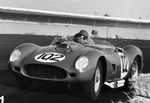 Jack Nethercutt, also known as J.R. Nethercutt, driving a Ferrari 250 Testarossa in a Cal Club regional event at Hanford in September 1960. (Note the hay bales on the inside of the turn, as well as the oval track in the background). Of Marchbanks, photographer Bob Tronolone said, "It had a road course in the infield that ran up onto the banking of the oval. It wasn't very successful. I went there one or two times. They really couldn't pull in anyone who was interested in road racing."Hemmings.com has a nice photo of a Ferrari 250 Testarossa -- one of only 34 made -- in a 1960 Sports Car Club of America (SCCA) race.
Jack Nethercutt, also known as J.R. Nethercutt, driving a Ferrari 250 Testarossa in a Cal Club regional event at Hanford in September 1960. (Note the hay bales on the inside of the turn, as well as the oval track in the background). Of Marchbanks, photographer Bob Tronolone said, "It had a road course in the infield that ran up onto the banking of the oval. It wasn't very successful. I went there one or two times. They really couldn't pull in anyone who was interested in road racing."Hemmings.com has a nice photo of a Ferrari 250 Testarossa -- one of only 34 made -- in a 1960 Sports Car Club of America (SCCA) race.
Frank Sheffield worked as a flagman at a July 4th SCCA weekend (he thinks in 1961) and recalled the track surface causing mayhem for motorcyclists.
"The surface was a little rough, I think, especially in the braking area near us. ... The rough parts were rough on the lighter vehicles, especially the two-wheeled ones. Several of the bike guys left patches of hot leather on the pavement near us. No broken bones. None they would admit to, I mean."
It's hard to tell from the Dick Wallen video whether the road course was in active use at the time of the USAC Stock Car race in 1964, although there's evidence of the smaller ovals.
The NASCAR connection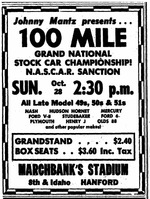 There's a ton of info in this October 1951 Bakersfield Californian ad from promoter Johnny Mantz touting the first big race at Marchbanks Stadium.The race on Oct. 28, 1951, the 37th of 41 races for the NASCAR Grand National series that year, drew 24 cars to Marchbanks. Dick Rathmann earned the pole, but Danny Weinberg’s 1951 Studebaker took the win and a $1,000 first prize. Nine entrants earned only $25 each from a total purse of $3,125.
There's a ton of info in this October 1951 Bakersfield Californian ad from promoter Johnny Mantz touting the first big race at Marchbanks Stadium.The race on Oct. 28, 1951, the 37th of 41 races for the NASCAR Grand National series that year, drew 24 cars to Marchbanks. Dick Rathmann earned the pole, but Danny Weinberg’s 1951 Studebaker took the win and a $1,000 first prize. Nine entrants earned only $25 each from a total purse of $3,125.
NASCAR was a regular sanctioning body for a variety of classes at the track nearly every year from 1954-1962. NASCAR events during that period included five races for the Pacific Coast Late Model series (now known as the K&N Pro Series West), as well as late models, jalopies, hard tops, claiming races, and Sportsman and Modifieds.
NASCAR's Grand National series did not return to Marchbanks until June 12, 1960 when the "California 250" drew 33 cars and 7,000 fans in the only California NASCAR race that year. Marchbanks regular Frank 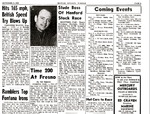 A small story inside the Nov. 6, 1951, edition of Motor Sports World documented the first NASCAR race at Marchbanks Stadium.Secrist of Bakersfield took the pole with a speed of 93 mph but Marvin Porter averaged 88 mph in winning by 46 seconds in a 1959 Ford, earning $2,000 from a total purse that ranged from $8,075 to $11,625 depending on the source. 1951 winner Danny Weinberg competed again but finished 28th, good for only $100.
A small story inside the Nov. 6, 1951, edition of Motor Sports World documented the first NASCAR race at Marchbanks Stadium.Secrist of Bakersfield took the pole with a speed of 93 mph but Marvin Porter averaged 88 mph in winning by 46 seconds in a 1959 Ford, earning $2,000 from a total purse that ranged from $8,075 to $11,625 depending on the source. 1951 winner Danny Weinberg competed again but finished 28th, good for only $100.
On March 12, 1961, the legendary Fireball Roberts dominated the track’s final Grand National race in a 1961 Pontiac, leading all 178 laps and winning by more than two laps in averaging 95 mph on his way to a $2,000 prize. Bob Ross averaged 98 mph in grabbing the pole. Ron Hornaday Sr. was among four drivers earning $0 from a total purse estimated at $9,000 to $11,475. Total attendance was not available. The Hanford race was one of four NASCAR races in California that year (Riverside, Los Angeles and Sacramento joined the schedule).
This video has no sound but some terrific views of the track at the 1961 NASCAR Grand National race and captures Chris Economaki interviewing race winner and legendary driver "Fireball" Roberts.
Weinberg and Lloyd Dane were the only drivers to compete in all three Grand National races at Marchbanks.
A December 1960 story in the Spartanburg Herald-Journal noted that Marchbanks Speedway was among 12 “major-league events” whose winners qualified for a NASCAR “Race of Champions” in February 1961.
Champ Car
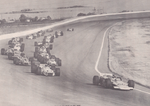 Joe Leonard leads the pack at the start of the November 1968 Champ Car race at Hanford. Note the huge 90-foot wide track.
Joe Leonard leads the pack at the start of the November 1968 Champ Car race at Hanford. Note the huge 90-foot wide track.
“Max Revs,” posting on Track Forum, recalls seeing “a couple of Hanford IndyCar races - on the old ABC Wide World of Sports” (a 10-minute "Car and Track" video summarizes the November 1968 race). Indeed, four Champ Car races were held from 1967-69 at what was now called Hanford Motor Speedway. All four were promoted by the legendary J.C. Agajanian, then a force in West Coast racing.
In addition, tire tests were held at the track in advance of the inaugural 1967 race, with A.J. Foyt, Art Pollard and rookie Bill Vukovich II of Fresno consistently lapping at more than 150  Art Pollard drove a turbo Offy in the 1967 race for Fresno's Gerhardt & Casey. Sponsor was Thermo King Auto Air Conditioning.mph, prompting the track to proclaim its race would be the fastest race ever held west of Indianapolis. Pollard was driving a turbo Offy, Vukovich the new super-charged Offy and Foyt a Ford V-8.
Art Pollard drove a turbo Offy in the 1967 race for Fresno's Gerhardt & Casey. Sponsor was Thermo King Auto Air Conditioning.mph, prompting the track to proclaim its race would be the fastest race ever held west of Indianapolis. Pollard was driving a turbo Offy, Vukovich the new super-charged Offy and Foyt a Ford V-8.
"On most tracks those turbo-powered jobs can pull on the straight but our Fords are better at the intermediate speeds and in cornering," Foyt said before the race. "Here at Hanford, the turns are about as fast as the straights and the Fords will be able to hand with the Offies all the way. So look out." 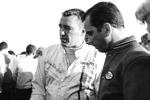 Johnny Rutherford was among the competitors in the November 1968 250-mile Champ Car race at Hanford. ((Photo Copyright ©2011 Ken Durham, www.GearHeadPhotography.com))The inaugural California 200 at Hanford was on Oct. 22, 1967. The program from the race proclaimed a “$20,000 Guaranteed Purse!” In fact, the total purse was twice that: $45,968 because Agajanian pledged 40 percent of the gate on top of a base purse of $18,350. Leaders of each lap were paid an extra $10, or $20 if the lap was sponsored.
Johnny Rutherford was among the competitors in the November 1968 250-mile Champ Car race at Hanford. ((Photo Copyright ©2011 Ken Durham, www.GearHeadPhotography.com))The inaugural California 200 at Hanford was on Oct. 22, 1967. The program from the race proclaimed a “$20,000 Guaranteed Purse!” In fact, the total purse was twice that: $45,968 because Agajanian pledged 40 percent of the gate on top of a base purse of $18,350. Leaders of each lap were paid an extra $10, or $20 if the lap was sponsored.
But numbers were tossed around like confetti in a variety of sources. For example, a Capital Times (Madison, Wis.) story on the 1967 race said "the total purse was $60,000 out of the $121,000 gate paid by the 20,000 fans."
And check out the entry list: Notables in the field included Mario Andretti, Bobby Unser, A.J. Foyt, Joe Leonard, Lloyd Ruby, Gordon Johncock, Kenyon, Gary Bettenhausen, Jim McElreath, Mike Mosley, Wally Dallenbach, Roger McCluskey, George Snider, Johnny Rutherford, and Al Unser.
Wow.
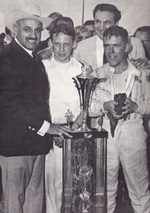 J.C. Agajanian, left, presents trophy to 1967 Champ Car race winner Gordon Johncock. Chief mechanic Duane Glasgow is in the center and trophy sponsor Paul Johnson, owner of a Ford dealership in Fresno, is behind JohncockJohncock took the win and $11,496 driving a Gerhardt Ford, covering the 200 miles in 94 minutes on a cool and overcast day. Rookie Bill Vukovich II of Fresno started 17th in his Shrike-Offy but finished last in the 26-car field, turning only 5 laps before retiring with a fuel leak. He earned only $229 in prize money.
J.C. Agajanian, left, presents trophy to 1967 Champ Car race winner Gordon Johncock. Chief mechanic Duane Glasgow is in the center and trophy sponsor Paul Johnson, owner of a Ford dealership in Fresno, is behind JohncockJohncock took the win and $11,496 driving a Gerhardt Ford, covering the 200 miles in 94 minutes on a cool and overcast day. Rookie Bill Vukovich II of Fresno started 17th in his Shrike-Offy but finished last in the 26-car field, turning only 5 laps before retiring with a fuel leak. He earned only $229 in prize money.
In addition to the Vukovich connection, Fresno car owners entered four Offies: Fred Gerhardt (with Mel Kenyon), Gerhardt & Casey (for Pollard) and Cave's Buick (for Al Miller); a car entered by Earl Smith was entered but made no qualifying attempt. Cars owned by Gerhardt, Cave's and Smith were to be regulars at all four Hanford Champ Car races.
Two Champ Car races were held at Hanford in 1968. The California 200 opened the 1968 USAC National Championship on March 17 and paid $32,518. Bobby Unser earned the pole with a 155.7 mph qualifying speed (or a 34.68-second lap) and led the most laps, but Gordon Johncock took the win and $8,130 in a Gerhardt-Offy on a cool and windy day. Attendance was not announced. Vukovich again finished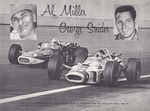 Bakersfield's George Snider drives his Ford underneath Al Miller, driving the Cave's Buick Offy, during the 1967 race. last, earning $163. He qualified eighth in a 1967 Mongoose-Offy but got in only six laps before retiring with a throttle problem.
Bakersfield's George Snider drives his Ford underneath Al Miller, driving the Cave's Buick Offy, during the 1967 race. last, earning $163. He qualified eighth in a 1967 Mongoose-Offy but got in only six laps before retiring with a throttle problem.
In the November race, the first 250-mile Champ Car race at Hanford, Joe Leonard shattered the qualifying record with a 163 pmh speed in his eerily quiet turbine-powered four-wheel-drive Lotus. The turbine was making its West Coast debut. And for the first time at Hanford, drivers were racing a distance that required a fuel stop.
A.J. Foyt won the race in a Coyote-Ford and earned $11,024. ABC Sports televised the race, paying $3,750 for the broadcast rights.
Reader Mike Franovich attended the race, and emailed me his memories:
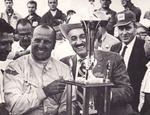 A.J. Foyt accepts the November 1968 race trophy from promoter J.C. Agajanian"The November race at Hanford in 1968 was a great race for several reasons. You had the turbo Offys, turbo Fords, the classic Ford DOHC and the turbines. You also had the usual variety of chassis found during this time period, including the four-wheel-drive Lola that Al Unser drove. This was the most competitive race I have ever watched. Foyt, B. Unser, and Andretti fought neck and neck throughout the entire second half of the race. Each driver led during this stretch, and they were never separated by more than a few car lengths. Foyt won the race, which gave the Turbo Ford its first victory."
A.J. Foyt accepts the November 1968 race trophy from promoter J.C. Agajanian"The November race at Hanford in 1968 was a great race for several reasons. You had the turbo Offys, turbo Fords, the classic Ford DOHC and the turbines. You also had the usual variety of chassis found during this time period, including the four-wheel-drive Lola that Al Unser drove. This was the most competitive race I have ever watched. Foyt, B. Unser, and Andretti fought neck and neck throughout the entire second half of the race. Each driver led during this stretch, and they were never separated by more than a few car lengths. Foyt won the race, which gave the Turbo Ford its first victory."
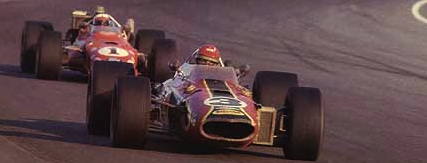 Bobby Unser leads A.J. Foyt during the November 1968 Champ Car race at Hanford. Unser's turbo V-8 was rated at more than 750 horsepower. Credit: From "Offenhauser" by Gordon Eliot White
Bobby Unser leads A.J. Foyt during the November 1968 Champ Car race at Hanford. Unser's turbo V-8 was rated at more than 750 horsepower. Credit: From "Offenhauser" by Gordon Eliot White
Reader Dan Ruth pointed out to me that Greg Weld was in the field, driving a Lesovsky-Offy dirt car. Compare his qualifying speed of 131.386 mph with Leonard's pole time of 163.200 mph in one of the turbine cars. Ouch!
"The two turbines were much faster than everyone else but even with two rotors per wheel the brakes would glow all race long. Leonard's brakes would eventually fail, giving the win to Foyt," Ruth wrote me.
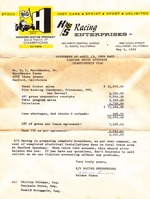 Financial breakdown from the final Champ Car race at Hanford.Attendance for the November 1968 race was announced at 15,470 and the total purse was $42,088. Tickets were $8 general admission, $10 for reserved grandstand and $12 for finish line seats.
Financial breakdown from the final Champ Car race at Hanford.Attendance for the November 1968 race was announced at 15,470 and the total purse was $42,088. Tickets were $8 general admission, $10 for reserved grandstand and $12 for finish line seats.
Vukovich fared much better in the second 1968 race, starting ninth and finished sixth in a 1968 Mongoose-Offy and earning $1,617.
The 1969 Champ Car race at Hanford on April 13 drew 12,085 fans and paid a total purse of $37,190. The average qualifying speed was 148.476 mph. Mario Andretti took the win under a red flag, ahead of Lloyd Ruby and Gordon Johncock. Andretti's prize money was either $6,900 or $8,686, depending on the source. Vukovich went back to the '67 Mongoose-Offy for this 1969 race, starting 13th, finishing eighth and taking home $1,300.
Here's a 10-minute video highlighting the November 1968 Champ Car race:
Deaths at the track
There are reports of at least three deaths at the track, in 1956, 1957 and 1969.
According to Motorsport Memorial, mechanic Arlen Smith, 22, was killed during a "500-lap Little Indianapolis hardtop jalopy race" at Marchbanks on May 29, 1956. Smith died after a wheel flew off one of the race cars and hit him in the back. (Oddly, the story also notes a second tire came off a different car in the same race, breaking the leg of a spectator near a concession stand).
FindAGrave.com details the death of Ernie Cornelson during a race on May 29. 1957, reporting the 29-year-old was "killed instantly when his hardtop car crashed during the 330-lap "Little Indy" at Marchbanks Stadium." The former Bakersfield resident rolled several times "after his car went out of control, slammed into a retaining wall and burst into flames. It was during the 148th lap of the race. The race was held up for an hour and 20 minutes."
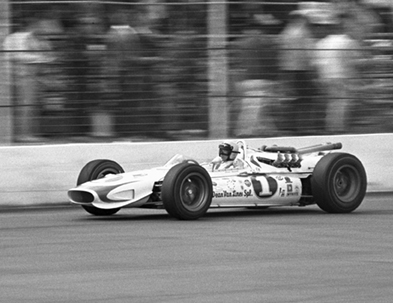 Mario Andretti in a Ford at Hanford Motor Speedway in 1967The 1969 USAC Champ Car race was marred by the death of James Darwin “Red” Stainton, a 38-year-old Fresno mechanic working for Art Pollard. According to The Associated Press, Stainton was critically injured on lap 70 of 134.
Mario Andretti in a Ford at Hanford Motor Speedway in 1967The 1969 USAC Champ Car race was marred by the death of James Darwin “Red” Stainton, a 38-year-old Fresno mechanic working for Art Pollard. According to The Associated Press, Stainton was critically injured on lap 70 of 134.
AP's report read:
"Art Pollard of Medord, (sic) Ore., came into the pit to refuel and his car burst into flames. One attendant, Grant King of Fresno, was burned, and Stainton, finding his coveralls on fire, leaped back into the path of Andretti's car. Both men were rushed off in the two ambulances at the track. Since the race would not proceed without one ambulance in attendance, the competition was delayed until one arrived. No times were kept as a result of the break. ... After the accident, Pollard got back into the race, but slammed into the wall in turn one and didn't finish. He wasn't hurt."
Stainton died two days later with serious head injuries, and second- and third-degree burns to his head and arms.
MotorSportMemorial.org published a detailed report of Stainton's death a few years ago:
"The accident used both available ambulances. A second Pollard mechanic was taken to the hospital with first and second degree burns, but he was released after treatment. With no ambulances available, the remainder of the race was driven to the finish under the yellow flag and Andretti was declared the winner.
"Red Stainton had a long career in racing as a mechanic, fabricator and driver. Originally working on Bill Vukovich's midget crew, Stainton eventually turned to driving. His best year as a racer was 1962, when he finished eighth in State of California points. He built and owned Bill Vukovich Jr.'s first Super Modified car. Later, Stainton worked for Fred Gerhardt on his Indianapolis team.”
"This certainly colors the rest of the day," AP quoted Andretti saying as Stainton was taken away in an ambulance.
I interviewed Andretti for this track history, and when I asked him if he remembered the pitlane incident, he didn't hesitate.
"How could I forget? I killed a guy. I could never forget that. There was a fire in the pit next to mine, and just as I drove into the pits one of the crew members dived right in front of me. I didn't see him."
People at the track that day agree Andretti was not at fault.
"There was nothing I could have done," Andretti said. "It was such a surprise."
Other series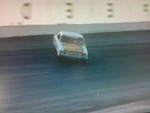 Lloyd Ruby spins in Turn 3 during the 1964 USAC Stock Car raceA variety of series raced at Marchbanks over the years, hosting motocycles and sports cars to jalopies and roadsters. There were even drag races for a time.
Lloyd Ruby spins in Turn 3 during the 1964 USAC Stock Car raceA variety of series raced at Marchbanks over the years, hosting motocycles and sports cars to jalopies and roadsters. There were even drag races for a time.
Sanctioning bodies such as the Valley Stock Car Racing association and the Valley Jalopy Racing association holding a nearly weekly schedule of jalopies, hardtops and roadsters as early as 1952 and into the mid-1950s. The track also hosted offbeat races, such as demolition derbies within the rodeo grounds. Figure 8s and "powder puff" derbies featuring women-only drivers. An outfit called ACRE hosted at least one stock car race in 1958.
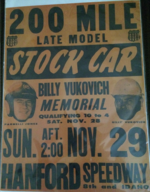 Parnelli Jones and A.J. Foyt were among the stars competing in the 1964 USAC stock car race at Marchbanks.At least one California Racing Association-sanctioned "big car" "Indianapolis-type" race was held in Fall 1958. CRA "big cars" raced at the track, at least in 1963 and 1964, according to WagTimes.com; 1965, according to Wheels of Speed; and February 1969 in a 100-mile Open Competition Supermodified and Caged Sprint Car Sweepstakes that meshed the two classes of high-speed cars. In that 100-mile February 1969 race, Johnny Parsons Jr. drove an ex-Indy roadster to the pole at 141.5 mph.
Parnelli Jones and A.J. Foyt were among the stars competing in the 1964 USAC stock car race at Marchbanks.At least one California Racing Association-sanctioned "big car" "Indianapolis-type" race was held in Fall 1958. CRA "big cars" raced at the track, at least in 1963 and 1964, according to WagTimes.com; 1965, according to Wheels of Speed; and February 1969 in a 100-mile Open Competition Supermodified and Caged Sprint Car Sweepstakes that meshed the two classes of high-speed cars. In that 100-mile February 1969 race, Johnny Parsons Jr. drove an ex-Indy roadster to the pole at 141.5 mph.
A URA-sanctioned midget race occurred on the half-mile asphalt oval in May 1959.
The United States Auto Club (USAC) staged two Stock Car series races in 1964 and 1965 at what it called "Hanford Motor Speedway" (despite large signage circling the track reading "Hanford Speedway").
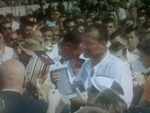 A.J. Foyt receives his trophy after his win in the 1964 USAC Stock Car race at Hanford. Foyt bounced off the wall several times en route to victory.The 200-mile season-ending race on Nov. 29, 1964, was called the Billy Vukovich Memorial and drew 6,500 fans and was televised on ABC's "Wide World of Sports." A.J. Foyt took victory, averaging 108 mph in a race full of spins.
A.J. Foyt receives his trophy after his win in the 1964 USAC Stock Car race at Hanford. Foyt bounced off the wall several times en route to victory.The 200-mile season-ending race on Nov. 29, 1964, was called the Billy Vukovich Memorial and drew 6,500 fans and was televised on ABC's "Wide World of Sports." A.J. Foyt took victory, averaging 108 mph in a race full of spins.
Joining Foyt in the 25-car field were legendary racers Ron Hornaday Sr., Parnelli Jones, Joe Leonard, Bobby Unser, Lloyd Ruby, Marvin Porter and Jud Larson (According to Ultimate Racing History, "Marvin Porter replaced Bobby Marshman, who was critically injured in a tire test in his Indy car at Phoenix the day before the race. Marshman died on December 4th in San Antonio, Texas.") 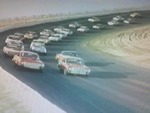 24 cars lined up for the start of the 1964 USAC Stock Car race at HanfordThe second USAC stock car race was on Nov. 28, 1965, and drew 9,224 fans and paid a $12,500 total purse. Pole speed was 44.11 seconds, and Norm Nelson took the win in a 1965 Plymouth, earning the USAC national championship in the process. Many of the big names from 1964 were not present at this year, but the race drew 31 starters, including Mario Andretti making his Hanford debut by finishing third in a year-old Ford. Other notables included Gary Bettenhausen, Hershel McGriff, Jim Hurtubise and George Snider. Local legend Al Pombo failed to qualify due to engine problems.
24 cars lined up for the start of the 1964 USAC Stock Car race at HanfordThe second USAC stock car race was on Nov. 28, 1965, and drew 9,224 fans and paid a $12,500 total purse. Pole speed was 44.11 seconds, and Norm Nelson took the win in a 1965 Plymouth, earning the USAC national championship in the process. Many of the big names from 1964 were not present at this year, but the race drew 31 starters, including Mario Andretti making his Hanford debut by finishing third in a year-old Ford. Other notables included Gary Bettenhausen, Hershel McGriff, Jim Hurtubise and George Snider. Local legend Al Pombo failed to qualify due to engine problems.  Dave MacDonald driving a Corvette on the Marchbanks road course on Sept. 1, 1960Mike Mueller’s book “Classic Corvette: The First 30 Years” has a nice photo of Dave McDonald muscling his Corvette at the track in September 1960.
Dave MacDonald driving a Corvette on the Marchbanks road course on Sept. 1, 1960Mike Mueller’s book “Classic Corvette: The First 30 Years” has a nice photo of Dave McDonald muscling his Corvette at the track in September 1960.
Sheffield, the flagman, recalls a funny experience at the track in which a race started while SCCA race official Merle Stanfield was stopped in Turn 1 when other track officials green-flagged a formula-car race. With no red flag handy down on the track, Sheffield was forced to use his red jacket to stop the race before the cars barreled into Stanfield.
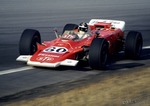 Joe Leonard driving Parnelli Jones' Lotus Pratt & Whitney in the November 250-mile Champ Car race at Hanford (Photo by John Wilson)The American Motorcycle Association held at least one race in conjunction with an SCCA weekend, including a 1960 race that featured national champion Joe Leonard, who later drove Indy Cars at the track. American Motorcyclist in February 1965 references two American Motorcycle Assocation races in 1961 as well as a Spring 1965 national road race at Hanford. American Motorcyclist reporter Roxy Rockwood -- who also served as an announcer at the track -- referred to the track as Marchbanks Speedway, which “can best be described as a ‘Baby Daytona.’ ”
Joe Leonard driving Parnelli Jones' Lotus Pratt & Whitney in the November 250-mile Champ Car race at Hanford (Photo by John Wilson)The American Motorcycle Association held at least one race in conjunction with an SCCA weekend, including a 1960 race that featured national champion Joe Leonard, who later drove Indy Cars at the track. American Motorcyclist in February 1965 references two American Motorcycle Assocation races in 1961 as well as a Spring 1965 national road race at Hanford. American Motorcyclist reporter Roxy Rockwood -- who also served as an announcer at the track -- referred to the track as Marchbanks Speedway, which “can best be described as a ‘Baby Daytona.’ ”
“The track is fast, but very safe. New promoters have taken it over 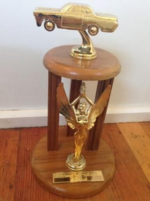 Trophy from a 1962 drag race at Marchbanksfrom the original builder and owner and have many big plans for the future for both cars and bikes.”
Trophy from a 1962 drag race at Marchbanksfrom the original builder and owner and have many big plans for the future for both cars and bikes.”
A Formula Racing Association meet was held around the same time, in 1965. The San Joaquin Region of the Porsche Club of America hosted an autocross in April 1965. A Madera Tribune article previewing the event quoted new owner Tommy Francis saying, "many competitors in recent events reached more than 125 miles per hour down the back straight and speeds of 75 to 80 miles per hour were common on two of the sweeping turns. A course average of more than 50 miles per hour was maintained by 'run-of-the-mill competitors."
Boat drags
The track layout unveiled in 1960 included an infield lake large enough to host quarter-mile flat-bottom dragboat races and water skiing. Gary Marchbanks said a world record speed of 114 mph was set at the lake; the boat was unable to stop and "went into the bank." Marchbanks relied on overflow irrigation water, pumped water and whatever rainfall to keep the lake full, but as any farmer can tell you, as time went on the cost of pumping water became expensive.
MotoRacing reported in 1960, "Although presently dried up, there is a lake one-half-mile long and with 2 islands in the infield of the new course, and for nearly 2 years Marchbanks also staged boat drag races."
Dave Lipinski, posting on Dragboatracing.com, recalls attending the first boat race at Marchbanks at about 7 years of age.
Howard Jaquith also shares a story on Dragboatracing about a Fuel Flat dragboat running on “the infield lake at Marchbanks Speedway” that couldn’t shut down in time and ran into “the tullies (sic).” Jaquith also recalls seeing one of the NASCAR races, as well as one USAC and “a bunch of crazy 8 races.”
Odds & Ends
MotoRacing also said, "For 5 years his plant was the scene of bloodless bullfights in which 'toreros' used plastic swords. This went by the boards when a law was passed banning the action." Gary Marchbanks offers a bit more detail, saying his grandfather originally was interested in horse racing but couldn't get a track approved so shifted his focus to auto racing. At various times over the years, the track featured a roping arena and hosted "Portuguese bullfights," bloodless versions of better-known Spanish bullfights.
The track also played host to boxing matches in 1963, with a variety of regional cards.
Tommy Trader told me he recalled participating in a sports car race -- the only time he drove on the road course -- during which the Blue Angels did a fly-by. The program for a September 1964 CRA "Big Car" 100-mile race chronicles a Blue Angels show on July 4, 1961, that drew 20,000 people inside Marchbanks Stadium (Hanford isn't too far from Lemoore Naval Air Station, where the Blue Angels show originated).
"Linker48x," writing on Track Forum, recalls "Memory of the Indy car race I saw there was a 13 inch wheeled rear engined Buick (?) built by Mickey Thompson. Did not go well, the turbo Offies ruled the day as I recollect, smoked the Fords."
The original King School house built in 1908 was later purchased by Bonnie Marchbanks and moved to Marchbanks Stadium, where the Hanford Sentinel reported "it was used as a meeting place for the drivers and officials. The stadium and the buildings were demolished in 1984, and the property reverted to farmland."
Wikipedia mentions “Hanford is being used in an upcoming Classic Champ Car game.” No other detail was provided, although I suspect it’s tied to the first post on the Hanford thread on Track Forum.
The end
A series of legal dispute between the Marchbankses and Kal Simon's K&S Racing Enterprises surfaced in the late 1960s. First, the Marchbankses demanded their original lease agreement be amended after the 1967 race, when they learned their share of ticket revenue only applied to tickets sold on site. Interestingly, or oddly depending on your point of view, presale tickets were unavailable at the track, thus skewing sales that counted toward the revenue share.
Relations deteriorated and by the time the 1969 race was held, K&S Enterprises was behind on rent to the Marchbankses and was being sued by a Fresno paving company for non-payment. Amid all this, K&S was attempting to consign its interest in the track to the owners of Michigan International Speedway. Those talks failed, and the track hosted its last race in 1969.
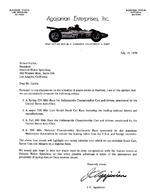 Promoter J.C. Agajanian promised to keep Hanford Motor Speedway busy -- if only the track had kept runningUSAC said that without improvements to the track infrastructure -- namely new stands, permanent restrooms, a new pitlane and paved parking -- it would not sanction races at Hanford.
Promoter J.C. Agajanian promised to keep Hanford Motor Speedway busy -- if only the track had kept runningUSAC said that without improvements to the track infrastructure -- namely new stands, permanent restrooms, a new pitlane and paved parking -- it would not sanction races at Hanford.
"It wasn't a good place to race on," Unser told me. "Lots of sand would blow on the track. It wasn't a completed race track. It needed an infusion of "finish it up."
Several efforts were made to fund improvements to save the track, including a $750,000 stock proposal in which Agajanian pledged to hold at least four "major" races per year": A 300-mile USAC Champ Car racer in the fall, a 250-mile USAC Champ Car race in the Spring, a 500-mile "late-model stock car race" and an AMA Motorcycle National Championship Race (indicating the road course was in semi-usable shape at that point). ABC Sports pledged to broadcast Champ Car events at the track.
 This spin during the California 250 Champ Car race shows the sand and dust that Bobby Unser said was a weakness of the track.Various published reports said 40 percent of stock was sold at one point, but the sale failed to generate enough investors, leading to local efforts to save the track. Fresno racecar builder Fred Gerhardt was among the interested parties, and Agajanian was so optimistic a deal would go through he lined up a Firestone tire test in 1970 and USAC tentatively scheduled a 150-mile March race and 200-mile October date on the 1971 Champ Car schedule. But all those efforts failed.
This spin during the California 250 Champ Car race shows the sand and dust that Bobby Unser said was a weakness of the track.Various published reports said 40 percent of stock was sold at one point, but the sale failed to generate enough investors, leading to local efforts to save the track. Fresno racecar builder Fred Gerhardt was among the interested parties, and Agajanian was so optimistic a deal would go through he lined up a Firestone tire test in 1970 and USAC tentatively scheduled a 150-mile March race and 200-mile October date on the 1971 Champ Car schedule. But all those efforts failed.
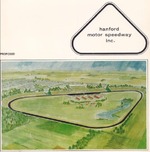 The cover of the 1970 document supporting the $750,000 stock sale included an artist's rendering of a renovated Hanford Motor Speedway."It would have made money had that stock sale gone through. It would have made money," Gary Marchbanks said firmly.
The cover of the 1970 document supporting the $750,000 stock sale included an artist's rendering of a renovated Hanford Motor Speedway."It would have made money had that stock sale gone through. It would have made money," Gary Marchbanks said firmly.
Yet hope simmered for a few years. A 1976 Bakersfield Californian article cited a Porterville Speedway official who had heard a group of businessmen "plan to get the old Marchbanks (Speedway) off the ground in early all with big car races after extensive renovations and the adding of 20,000 seats."
That rumor had no legs, and the track sat silent until its demolition in 1984, shortly after the track was sold to Gary's brother-in-law Rolland Gonzalves.
"It was tragic we couldn't keep that thing going," Trader said of the track. "Tragic."
Gary's voice cracks a bit as he thinks about the speedway, which was just a half mile north of his current home and walnut farm. "We used to go in and drive around it and mess around. What I miss is it's just not there. It might not have been running but it would have been there. ... I don't have any regrets. I'd have just liked it to be there."
“Hubbster,” posting on Track Forum, recalled seeing the track from the air "right up until it was plowed over. It was a distinct track. All I can compare it to is Pocono. It looked like a little Pocono to me.”
The West Coast Stock Car Hall of Fame announced in early 2012 that it would induct B.L. Marchbanks as part of its "historic division" governing people from 1930-1970. A fitting tribute, even if it's overdue recognition.
Sources
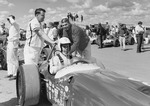 One of the many excellent photos from George Benson's book "The Racing Years." This shot from the March 1968 race shows Benson in the car, with car owner Vince Conze on the right. (Photo courtesy of George Benson).American Motorcyclist magazine, "Western Views, Feb. 1965
One of the many excellent photos from George Benson's book "The Racing Years." This shot from the March 1968 race shows Benson in the car, with car owner Vince Conze on the right. (Photo courtesy of George Benson).American Motorcyclist magazine, "Western Views, Feb. 1965- "The American Stock Car," By William Burt.
- Andretti, Mario. Personal interview, May 2011.
- AutoRacingMemories.com, "Profile ... Johnny Rostek"
- The Bakersfield Californian, various articles and ads from 1951-1976.
- Benson, George. Email exchanges in April 2011
- Bolton, Harold "Bucky." Email exchanges, July 2010.
- Capital Times, Madison, Wis., 1967.
- "Classic Corvette: The First 30 Years" by Mike Mueller
- The (Hayward) Daily Review, 1969
- Dayton, Bob. Email exchanges, March 2011
- Dick Wallen Racing Classics, "Stock Car Classics Vol. 1"
- Dragboatracing.com, "Drag boat racing in California" (page since taken offline).
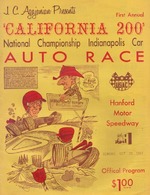 The race program for the inaugural Champ Car race in 1967 (PDF download)Durham, Ken. Email exchanges in May-June 2011 and contributed photos courtesy of GearHeadPhotography.com.
The race program for the inaugural Champ Car race in 1967 (PDF download)Durham, Ken. Email exchanges in May-June 2011 and contributed photos courtesy of GearHeadPhotography.com.- Everythingstockcar.com, "1951-37 Nascar Race" at Marchbanks Speedway, "1960 California 250 - NASCAR race"
- FindAGrave.com, Ernest George "Ernie" Cornelson
- Franovich, Mike. Email exchanges, October 2010
- Frye, Trudy. Email exchanges, May 2010
- "Gold Thunder: Autiobiography of a NASCAR Champion" by Rex White and Anne B. Jones
- Hanford Motor Speedway race programs for Champcar races in 1967, March 1968, November 1968 and 1969, and a CRA "Big Car" race in September 1964
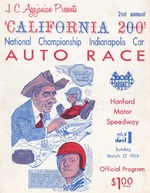 PDF of 36-page program for March 1968 USAC Champ Car race at Hanford Motor SpeedwayHanford Sentinel, "Racing Notebook: Former Speedway owner Marchbanks honored," July 13, 2012
PDF of 36-page program for March 1968 USAC Champ Car race at Hanford Motor SpeedwayHanford Sentinel, "Racing Notebook: Former Speedway owner Marchbanks honored," July 13, 2012- "Hoot's Histories: King," Hanford Sentinel, April 16, 2005
- Hemmings.com, "Written in Red"
- "The History of the American Speedway" by Allan E. Brown
- Kenyon, Mel. Telephone interview, March 2011
- Lawton (Okla.) Constitution, Nov. 29, 1965.
- Madera (Calif.) Tribune, "Autocross At Hanford's 1.9 Track Sunday," April 8, 1965.
- Marchbanks, Gary. Personal interview in December 2010.
- "Mel Kenyon: King of the Midgets"
- Microsoft Research Maps: U.S. Geological survey maps of the track area in July 1954, 1971 and 1993
- The Modesto Bee, "Pit Stop" by Art Glattke, Oct. 1, 1970
- MotoRacing, Vol. 5, Issue 24 (Sept. 30-Oct. 7, 1960) and Vol. 6, Issue 18 (July 7-14, 1961)
- Motorsport.com.
- Motorsportforums.com, "OT-40 years ago 1968 Greatest Season of them all"
- MotorsportMemorial.org, "Arlen Smith" and "Red Stainton"
- NASCAR K&N Pro Series West 2010 Media Guide
- Nunes, Grace. Email exchange, June 2015.
- Oakland Tribune, various articles from 1960-70
- OneDirt.com, "Dirt tracks across America - Nedyour help"
- Racing-reference.info, "1960 California 250," "Marchbanks Speedway," "1961-08," "NASCAR Sprint Cup Drivers Statistics for Marchbanks Speedway," 1967 "Hanford 200," 1968 "California 200," 1968 "Hanford 250," 1969 "California 200"
- ""The Racing Years: A Memoir of the Life and Times of a Racer, 1952 to 1987," George Benson
- Reading Eagle, "Pit Mishap Mars Victory for Andretti," April 14, 1969
- Rumbledrome.com, "Winners for Races of Championship Cars, 1960-69"
- Ruth, Dan. Email exchange, March 2011
- San Francisco Chronicle, "Indy Cars in California," Oct. 18, 1967
- San Mateo Times, Sept. 16, 1965.
- Sheffield, Frank, recollections from personal website (lots of great historic photos from other tracks and eras)
- Silhouet.com
- Spartanburg Herald-Journal, "Three Spartans Invited for 'Race of Champions'," Dec. 18, 1960
- "The Stock Car Racing Encyclopedia," edited by Peter Golenbock and Greg Fielden
- Studebakerracing.com, "NASCAR Short Track Series"
- Terre Haute Tribune Star, Nov. 15, 1970.
- The News, Van Nuys, Calif., "Veteran Trio to Compete in Hanford Race," Nov. 1, 1968
- The Racing Line
- Track Forum: 1) thread titled "Hanford Speedway"; Many excellent posts from fans with deep knowledge of the track during its different phases; 2) thread titled "Record Sprint Car Races".
- Trader, Tommy. Personal interview in January 2011.
- Tulare Motor Sports Complex
- UltimateRacingHistory.com, "California 200," "Billy Vukovich Memorial," "USAC Stock Car Race, Hanford Motor Speedway, Hanford CA, Nov. 28, 1965"
- Unser, Bobby. Personal interview, April 2011.
- ValleySportsPulse.com, "Reliving Hanford's Racing History"
- VintageMotorsportPhotography.com (now offline)
- Vukovich, Bill II; phone interview in March 2011
- Wagtimes.com, "In Memory of Our Loved Ones"
- West Coast Stock Car Hall of Fame, "West Coast Stock Car Hall of Fame Announces 2012 Inductees and New Board Members"
- WheelsofSpeed.com, "This Day in Motorsports for May 29th"
- Wikipedia, "Marchbanks Speedway"
- YouTube, "1968 California 250" (video since taken offline)
 Logan Molen
Logan Molen
I added a bunch of updates to this main history. Changes are detailed in this story in my Marchbanks section.
 Logan Molen
Logan Molen
I added more updates throughout the Marchbanks section and the main track history. Those changes are detailed in this post in my Marchbanks section.
 Logan Molen
Logan Molen
I added some track history found in a race program from the September 1964 CRA "Big Car" race at the just renamed Hanford Speedway. The program included the first conclusive dates as to when racing of any kind (horse and auto) began at Marchbanks Stadium.

Reader Comments (21)
http://home.roadrunner.com/~fsheff/olds.htm
That's my (1961?) story, and I'm sticking to it...
Cheers!
Great story, Frank.
One more example of how course workers are the unsung heroes at races around the world.
Hi, This was my family's racetrack, B.L. Marchbanks is my Great Great Grandfather, I was wondering if there was anymore information you had or wanted? Feel free to contact me.
My Dad built a large two story house on right on the corner of 7th and Houston ave. I remember as a small boy going up to the roof with my Brothers to watch the cars go around the track in the far distance. We moved in 1970 but I went back there in the late 70's or early 80's and found the track. While walking around an angry farmer quickly drove up in a pickup and jumped out to tell me I was trespassing. I apologized and left but at least I got to finally be at the track to dream of what it would have been like to be there to see a race. Does anyone from there remember the Martella, Mello or Champlin Familys?
I have the Official Program for the 2nd Annual California 200 National Championship Indy Car Auto Race held at Hanford Motor Speedway on Sunday March 17,1968.It sold for $1.00......On the front page is a cartoon picture of JC Agajanian,,AJ Foyt,,and Danny Ongais in his #68 car..I also have the lap times and speeds for all the drivers except Jim Malloy in the Jim Robbins Seat Belt Spl#67,,Danny Ongais
in the Micky Thompson Spl#68,And Bob Hurt in the #26 Ramaho Spl...
Art Pollard had the record time of 34.88 seconds with a speed of 154.816 mph..Billy Vukovich drove
JC Agajanians #98 car that year for a 1st lap time of 36.01 at 149.958 mph & his 2nd lap was 35.38 at 152.628 mph..Chuck Hulse was driving the Quaker state Oil Spl that year owned by Caves Buick Company..There was 1 chevy dirt car in the field.1 offy dirt car and 1 offy roadster driven by George Benson..The Official Pace car for the 2nd annual Califonia 200 was courtesy of PAUL JOHNSON FORD Fresno Ca..Im sure his ph # is no longer 222-6541
Sorry i made a mistake when i said Art Pollard had the record time.It was really Bobby Unser in the Rislone Spl..1st lap time was 35.06 at 154.021 mph and the 2nd lap was 34.68 at 155.709 sorry about that..
Thanks for the great history of Big H speedway as I remember it being called. I used to have a sticker of it on my tool box. I grew up in Caruthers Ca. which is just a few miles from Hanford and although I used to hear about the speedway I never got to visit. thanks again.
Sir I am the person that was the owner of the VJRA. The first race that was run at Marchbanks was with my Ass. cars. The track was dirt 1/4 mile in the rodeo grounds. The stands were on the south side of the track.You mght not want to talk to me because i sure have a different story about a lot of things. I was there and what I saw is different from lots of things that is posted on this history.. Red Mullican
I own the piece of ground where the track once stood. As a kid I remember it well. We farmed all our lives in the area and my dad was at most of the races. We still find pieces of asphalt in that field to this day. It is called our race track ranch field # R1.
Anyone remember seeing a1857 either blue or white Corvette race at this track or near Madera?
Clarence Hager of Caruthers,CA raced in this area.
Any pictures or info?
57airbox@gmail.com
A couple friends and I attended a Champ Car race there in either 1967, 68', or 69'... my memory is not what it once was. We were attending West Hills J.C. (back then Coalinga Jr. College), at the time. I very much disagree with Vukovich's comment wondering why the track should be remembered because it was in the middle of nowhere. Being in the 'middle of nowhere' is precisely what made it so great, and gave it it's charm. I don't like admitting this next but having no extra money we 'snuck' in, not difficult to do back in those days. It was my first Champ Car race and as a long time Indy fan I was star struck seeing my heroes that day. Mario, AJ, et al. It was many years later before I saw them again, 1991 to be exact, when I traveled to Indy for the 500. Been back a couple of times since then; there is nothing quite like Indy, HOWEVER... that day in the late 60's at Hanford, (the middle of nowhere), may be my fondest racing memory. You never forget your first. <smile> My thanks for the excellent research in presenting this story - one VERY much worth telling, and remembering. - JamesJM
I have a picture of an old race advertisement from the track. Let me know if you'd like it.
Your history has been most helpful to me. I have compiled an online encyclopedia of drag strips at dragstriplist.com Marchbanks Speedway ran NHRA-sanctioned races in 1962. I would be interested in your best guess as to what specific part of the speedway was used for the drag racing. I haven't found any news reports about the drag races, only newspaper ads and listing in Hot Rod Magazine.
Thanks, Mel.
I've never been able to unearth much info on the drag races there.
In response to your question, I did find an online forum reference that suggested the 1962 Marchbanks drag races were held on a quarter-mile segment of the front stretch, running counterclockwise. There was a slight kink on that front-stretch at that time so it'd be interesting to learn more about how that was pulled off. I have no other information on that but will try to chase that down.
I was raised in Lemoore, about 15 miles from Marchbanks. Saw many races there. Unfortunately seeing a sprint car driver killed when he hit a pole in the infield on the front straight in a California Roadster Association (still called that at the time and included some old style roadsters). I was at a race in July 1961, actually scoring the 500cc FIII race, when Mike Smith missed a turn due to the heat and hit the hay bales in a Kieft. Actually bought it fro Harry Morrow years later and tried, unsuccessfully, to rebuild it. Definitely remember Tommy Trader, drove the Drake owned by Pat Hargrove from Lemoore. I was also involved in micro midgets in Lemoore at the old 1/8 the mile track by the golf course, helping my neighbor, Gary Burrows.
Could you tell me more about the Marchbanks family and if a driver named Corliss Marchbanks was part of this family, thank-you.
H.,
Everything I know about the Marchbanks family is posted in this story or this article I wrote about my interview with Gary Marchbanks: http://www.loganmolen.com/marchbanks/2010/12/27/my-interview-with-gary-marchbanks.html
I've seen references in online forums to a Corliss Marchbanks and suggesting he founded Marchbanks Speedway, but all reputable sources I have found refer to B.L. Marchbanks as the founder. Beyond that, I know nothing of Corliss Marchbanks.
I grow up less then a mile from the track...Was heartbroken when it was gone too...My family also raced there in there Drag races..I still to this day have wood planks that make a walk way out side my bedroom window....The planks were from the bleachers seats...They still are multi color paint ....Each color was basically different. For decades it was part of the bleachers.
I remember this racetrack well!! My grandparents were about 1 mile away and I sounds of race cars on the track were easy to hear. After it closed, my brothers and I took our motorcycles on the track (1972ish) and raced around. A memory I'll never forget! Thanks for the memories and extensive article!
Hi My Dad worked for MarchBanks tractor / farming . We lived in one of the little wooden houses . Dad was Bart Franks .
Thank you for the memories. I was conducting research on the track as I remember it from my youth. My father raced an open wheel there and was also with the Kings County Ambulance. I remember him building the car and taking it to the track, and seeing the ambulance he was driving on TV as it responded to a collision. My father has passed, and i'll use some of his pictures of the car in his memorial.
Thanks for keeping the memories alive.